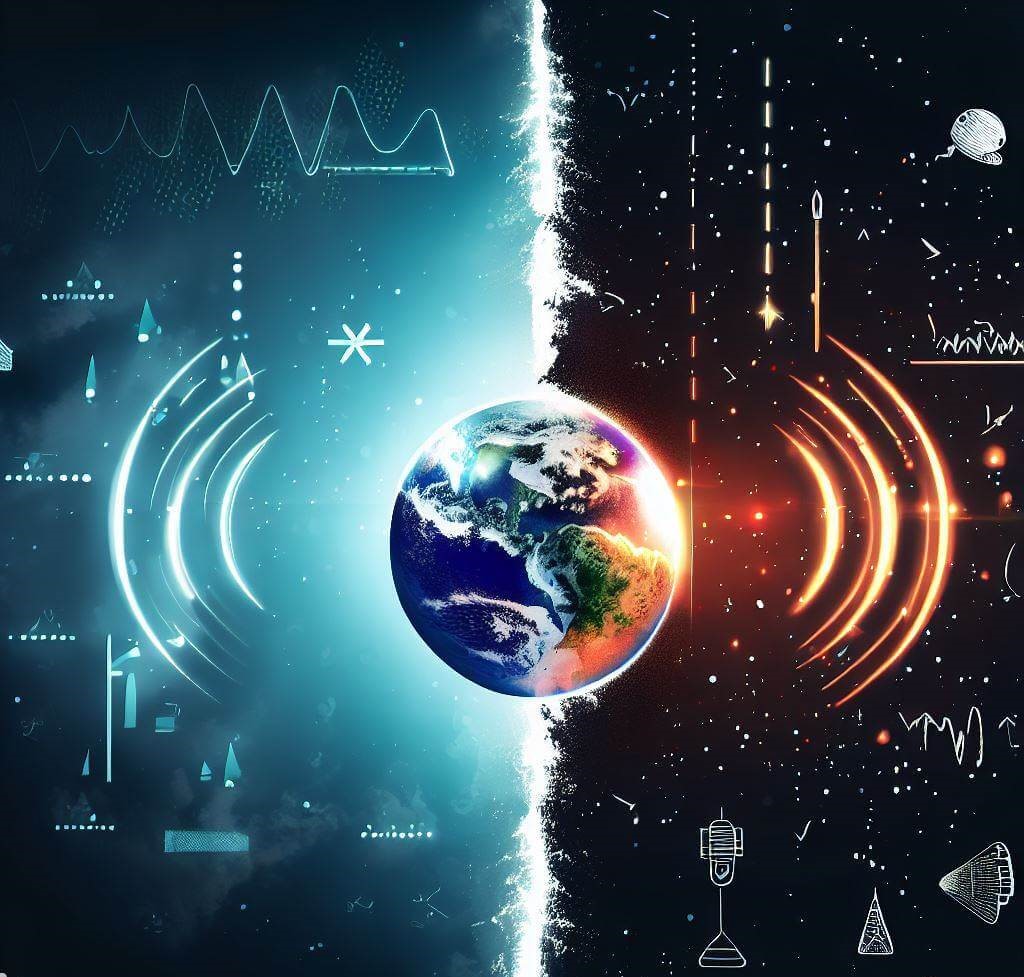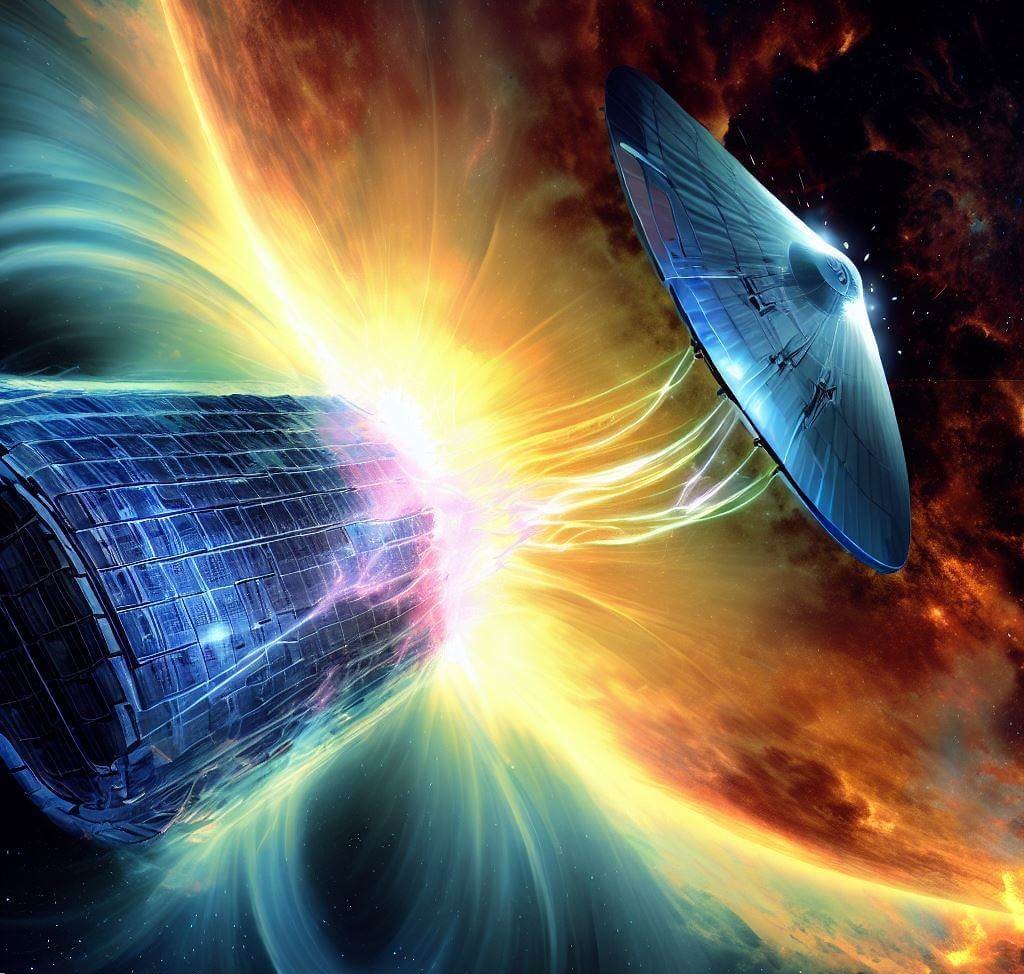The Invisible Threat from Space
The cosmos fascinates and intrigues us, drawing our gaze to the star-studded expanses above. As we venture into the realm of space exploration, we’re not just dealing with near-zero gravity and the vacuum of space, but an invisible threat—space radiation. What’s more, the concept of electromagnetic fields (EMFs) extends its reach far beyond our planet Earth, with significant implications for our health and technology in outer space.
Understanding Space Radiation
Types of Space Radiation
There are primarily two types of radiation in space: Galactic Cosmic Rays (GCRs) and Solar Particle Events (SPEs). GCRs originate from outside our solar system and consist of high-energy protons and heavy ions. SPEs, on the other hand, are bursts of radiation from the sun, typically associated with solar flares and coronal mass ejections.
The Origins of Space Radiation
GCRs are remnants of supernova explosions, while SPEs result from violent events on the sun. This space radiation, unlike the EMFs we encounter on Earth, is ionizing, meaning it carries enough energy to remove tightly bound electrons from atoms, potentially leading to damage at the cellular level.

Space Radiation and Human Health
Effects of Space Radiation on Astronauts
The impacts of space radiation on human health can range from immediate effects like radiation sickness to long-term issues such as cancer and damage to the central nervous system. This is a significant concern for astronauts on long-duration missions, especially those beyond Earth’s protective magnetic field, like the planned missions to Mars.
Earth’s Protection Against Space Radiation
Earth’s magnetic field, often referred to as the magnetosphere, acts as a protective shield against most space radiation. It deflects many of the high-energy particles, making life possible on Earth. Without this natural barrier, the impacts of radiation would be detrimental to all forms of life.
EMF and Space Radiation
Electromagnetic Fields in Space
Apart from ionizing radiation, astronauts in space also encounter electromagnetic fields. The EMF sources in spacecraft include onboard electronic systems, communication devices, and even the Earth’s own magnetic field. Although the frequencies of these EMFs are much lower than the ionizing radiation from space, their constant presence warrants study and monitoring.
Understanding Space Radiation
To truly grasp the risks and challenges posed by space radiation, we must first understand what it entails. Space radiation is vastly different from the type of radiation we encounter here on Earth. It primarily consists of galactic cosmic rays (GCRs) and solar particle events (SPEs).
GCRs are atomic nuclei from which all of the surrounding electrons have been stripped away during their high-speed journey through the galaxy. They are of particular concern for long-duration space missions because they come from all directions and are difficult to shield against.
On the other hand, SPEs, which include solar flares and coronal mass ejections, are bursts of radiation from the sun with energy levels high enough to pose a health risk to astronauts, especially those outside the protective magnetic field of the Earth.
As if these sources were not enough, astronauts also have to deal with radiation from the Van Allen Belts – zones of energetic charged particles that are held in place around Earth by the planet’s magnetic field.

Health Risks of Space Radiation
Space radiation can have serious immediate and long-term health effects. In the short term, exposure to high levels of space radiation can cause radiation sickness, a condition with symptoms such as nausea, weakness, hair loss, skin burns, and reduced organ function.
In the long term, space radiation can increase the risk of cancer, cause damage to the central nervous system, induce acute and late degenerative changes in the cardiovascular system, and cause damage to other body tissues.
It’s also worth noting that space radiation can have synergistic effects with other spaceflight factors, such as microgravity and psychological stress, leading to immune dysfunction and possibly increasing the risks of infection and cancer.
The Role of EMF in Spacecraft
Amid these daunting risks of space radiation, EMF still has an essential role to play. It’s not all about the dangers; EMF is integral to the functionality of any space mission. All modern spacecraft use electronic systems for navigation, communication, and operating onboard scientific equipment. These systems generate EMF, which astronauts are exposed to during their missions.
Although the levels of EMF aboard spacecraft are much lower than those of ionizing space radiation, there are still concerns about their potential biological effects due to the constant exposure during long-duration missions.
Shielding Against Space Radiation and EMF
So, how do we shield against space radiation and manage EMF levels aboard spacecraft? Well, several strategies are currently in use and under development.
Firstly, spacecraft and space suits are built with radiation-protective materials. These materials are designed to reduce exposure to space radiation, but they cannot completely eliminate it, especially for GCRs.
For EMF, one of the strategies is the careful design and arrangement of onboard electronic systems. By placing major EMF sources away from frequently occupied areas, astronauts’ exposure can be reduced. However, given the size constraints of spacecraft, this approach has its limits.
Secondly, there is active research into new materials and technologies for radiation shielding, such as hydrogenated boron nitride nanotubes (hydrogenated BNNTs) and other nanomaterials.
The Intersection of EMF and Space Radiation Protection
One fascinating development in our pursuit of EMF and space radiation safety is the intersection of these two fields. As we strive to understand and manage both, we’re beginning to see that they are not entirely separate matters. Some technologies and strategies can potentially address both concerns simultaneously.
One of these is the concept of electromagnetic shielding. Traditional shielding methods against space radiation have involved physical barriers, often made of materials with high hydrogen content, to absorb or deflect incoming particles. However, these are not entirely effective against high-energy particles like GCRs.
The concept of electromagnetic shielding takes a different approach. Rather than using passive physical barriers, it involves generating an active electromagnetic field around a spacecraft or habitat. The idea is inspired by the Earth’s own magnetic field, which protects us from most space radiation.
A strong enough EMF could potentially deflect high-energy particles, effectively providing better protection against space radiation. However, this approach brings its own challenges. We’d need to generate a significant EMF, which requires a lot of power and could itself present EMF exposure risks to astronauts.
Understanding and managing the balance between these factors is a complex task. Too strong an EMF, and we risk harmful health effects from the EMF itself. Too weak, and it may not provide effective protection against space radiation.
Nevertheless, with further research and development, the concept of electromagnetic shielding offers an exciting possibility. It could give us a more effective way to shield against space radiation while also managing the EMF environment that astronauts are exposed to.
In essence, we’re seeing that our understanding of EMF and its potential applications extend far beyond our planet. As we delve deeper into space, this knowledge will become increasingly crucial, as will our efforts to manage EMF and protect those who dare to venture into the vast expanse beyond our world.

The Future of Space Travel and EMF Safety
With ambitious plans for human missions to Mars and the desire to establish human settlements on other planets, we need to step up our efforts to protect astronauts from space radiation and manage EMF exposure.
For space radiation, one of the main challenges is developing effective shielding for GCRs. Scientists are researching the use of advanced materials and even novel ideas such as creating a mini magnetosphere for spacecraft.
For EMF, the long-duration nature of future missions means that we need to pay more attention to the chronic effects of low-level EMF exposure. The use of EMF-emitting devices will likely increase with the complexity of future missions, making this a crucial area of study.
Also, we need to think about the EMF environment in habitats on other planets. The extensive use of electronic devices in these habitats will create an EMF environment that inhabitants will be exposed to around the clock.
As we continue to push the boundaries of space exploration, ensuring the safety of our astronauts from space radiation and EMF becomes an ever more complex and critical task. However, with continued research and technological advancements, we are steadily gearing up to meet these challenges. Through our understanding and management of these invisible yet potent forces, we pave the way for the next giant leaps in our spacefaring journey.

How Spacecrafts Protect Against EMFs and Space Radiation
Modern spacecraft are designed to shield occupants from both EMFs and space radiation as much as possible. This includes shielding materials like high-Z materials for space radiation and the placement of equipment to minimize the EMF exposure inside the cabin. Despite these efforts, complete shielding in space remains a significant challenge due to the ubiquitous presence of these fields and particles in the space environment.
The Future of Space Travel and EMF Protection
As we forge ahead towards a future with more frequent and lengthy space missions, understanding and mitigating the effects of space radiation and EMFs becomes even more critical. Continuous research is being carried out to devise new materials and technologies for improved radiation shielding. Similarly, advancements in spacecraft design aim to reduce onboard EMF levels without compromising functionality.
The recent interest in human settlements on other planets brings another set of challenges. Unlike Earth, planets like Mars lack a strong magnetic field to shield against space radiation. Future habitats on these planets will need to account for this, possibly utilizing local resources for radiation shielding. Furthermore, the EMF environment inside these habitats, created by the extensive use of electronic devices, will need to be managed to ensure a safe living environment.
Conclusion
In conclusion, understanding EMFs goes beyond the scope of Earth and into the depths of space. As we push the boundaries of space exploration, the need to understand and protect ourselves from space radiation and EMFs becomes increasingly vital. From the health of our astronauts to the safe operation of our technology, these invisible forces play a significant role in our venture into the cosmos.
Frequently Asked Questions
- What types of radiation exist in space? Space is filled with Galactic Cosmic Rays (GCRs) and Solar Particle Events (SPEs), which consist of high-energy protons and heavy ions.
- How does space radiation affect astronauts? Space radiation can have immediate effects like radiation sickness and long-term impacts such as increased cancer risk and damage to the central nervous system.
- How does Earth protect us from space radiation? Earth’s magnetic field, or the magnetosphere, acts as a protective shield against most space radiation, deflecting many of the high-energy particles.
- How are astronauts protected from EMFs and space radiation in spacecraft? Modern spacecraft use a combination of shielding materials, equipment placement, and design strategies to minimize exposure to both EMFs and space radiation.
- What are the considerations for EMF safety in future space missions and extraterrestrial settlements? Future missions and settlements will need to consider enhanced radiation shielding, particularly on planets without a strong magnetic field. The EMF environment inside habitats will also need to be managed to create a safe living space.

